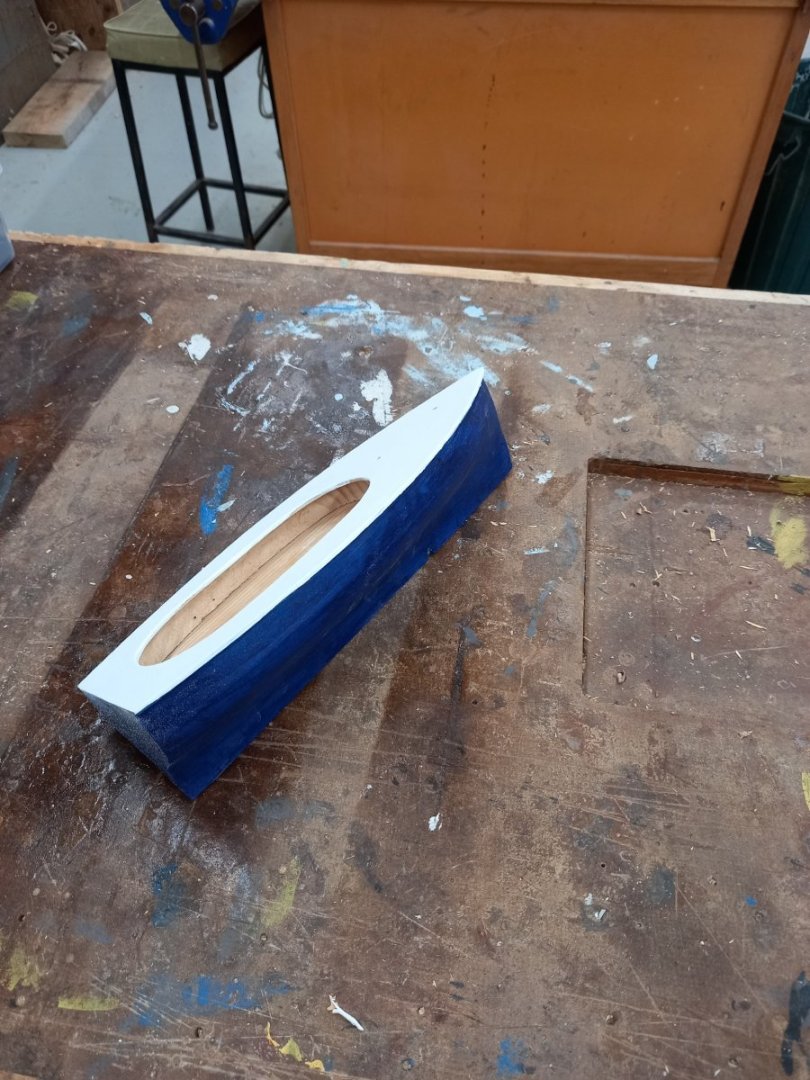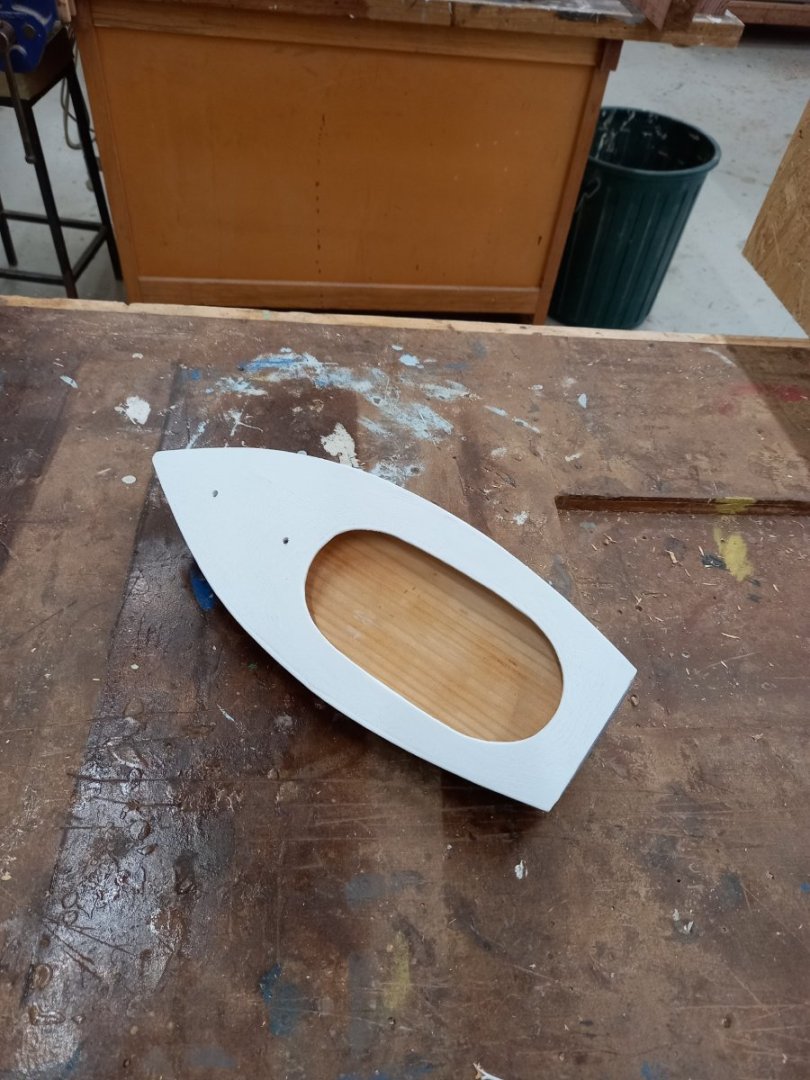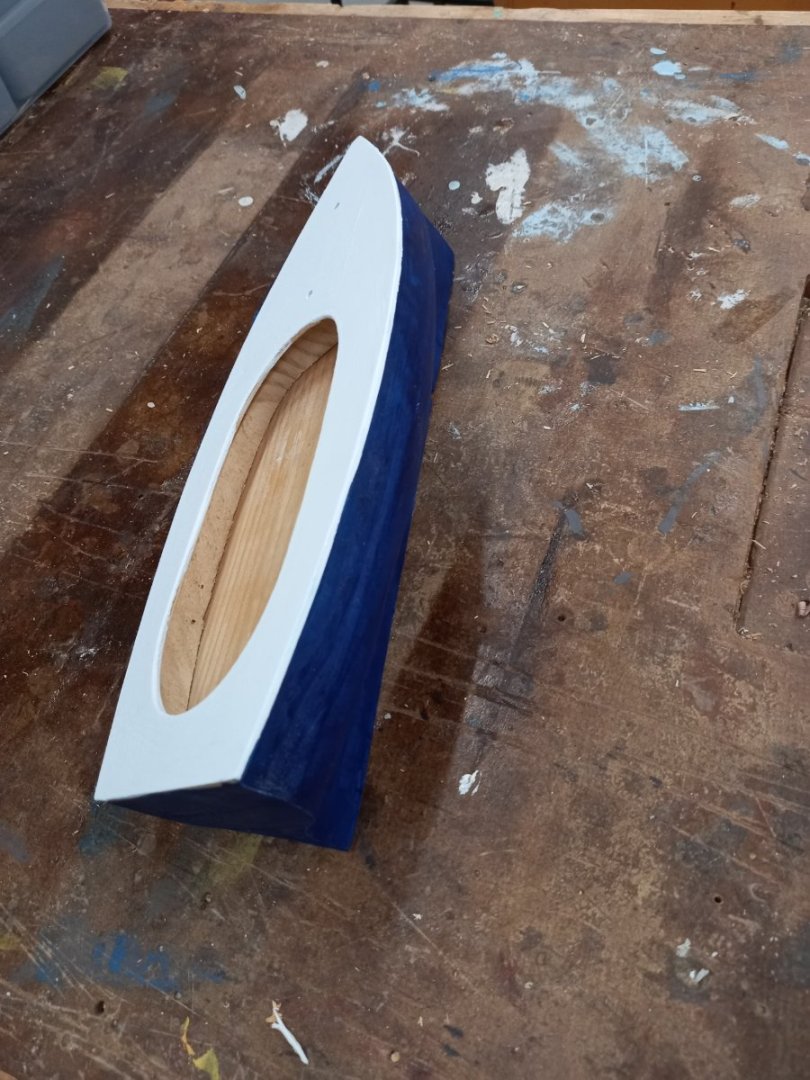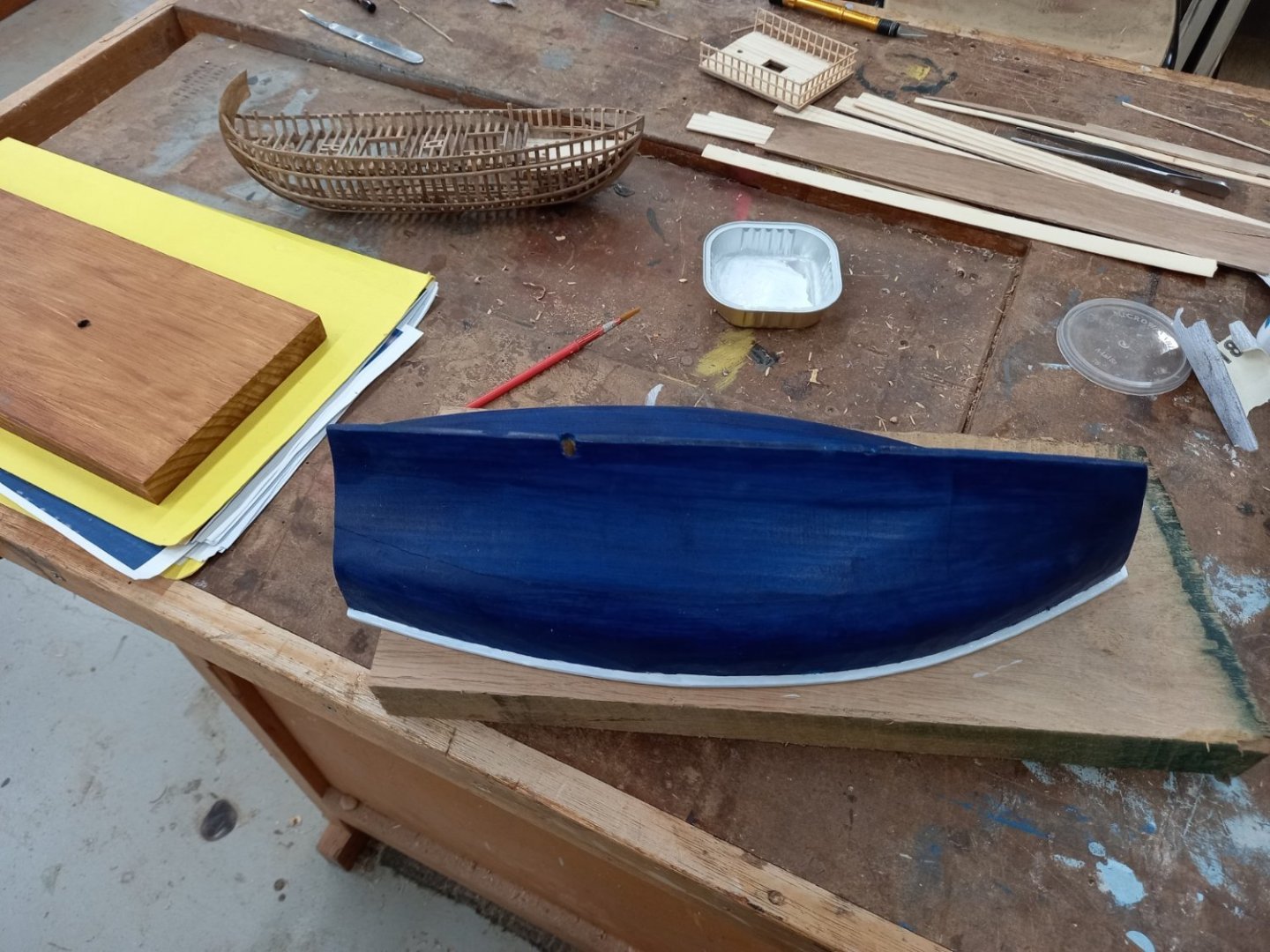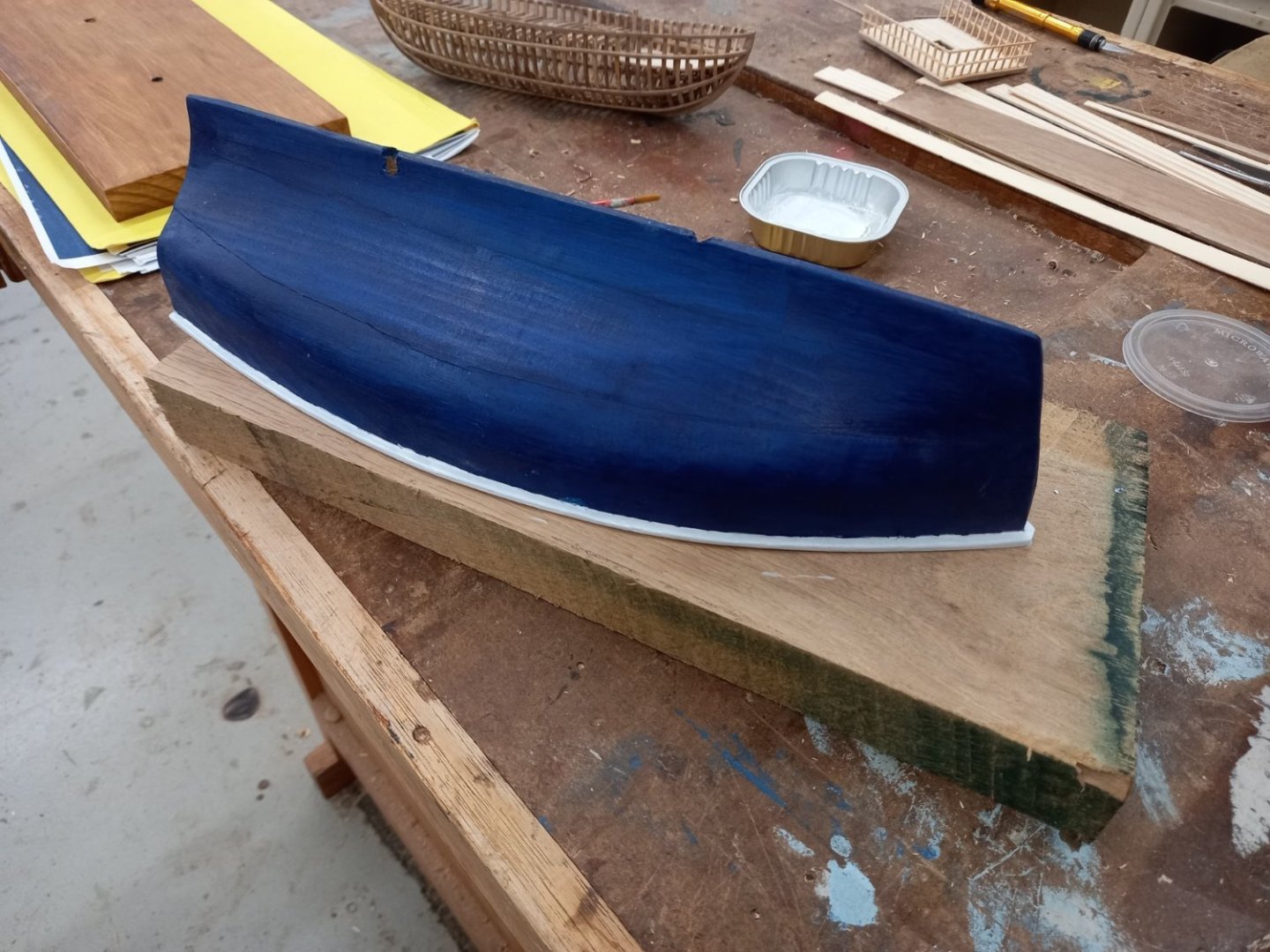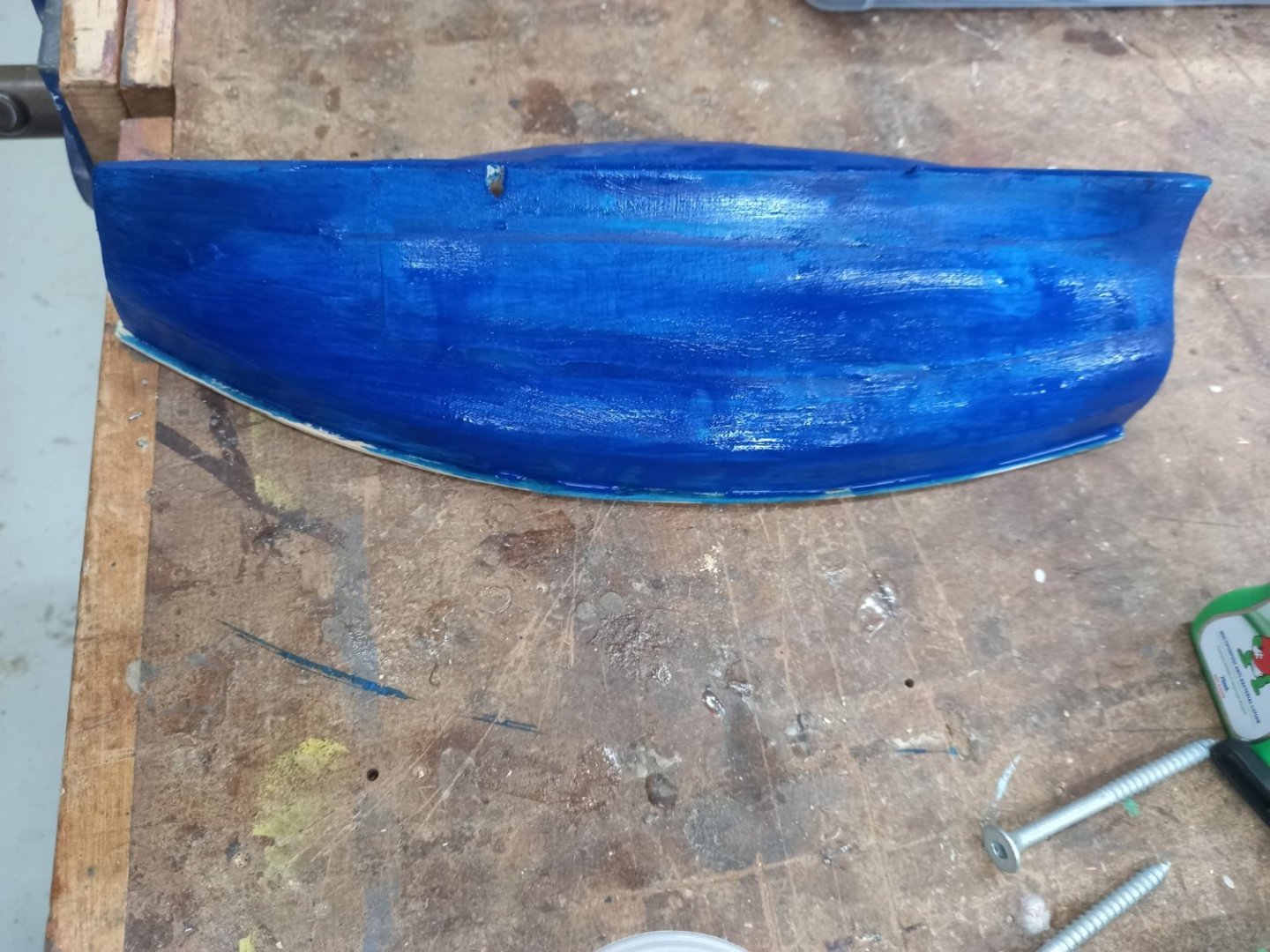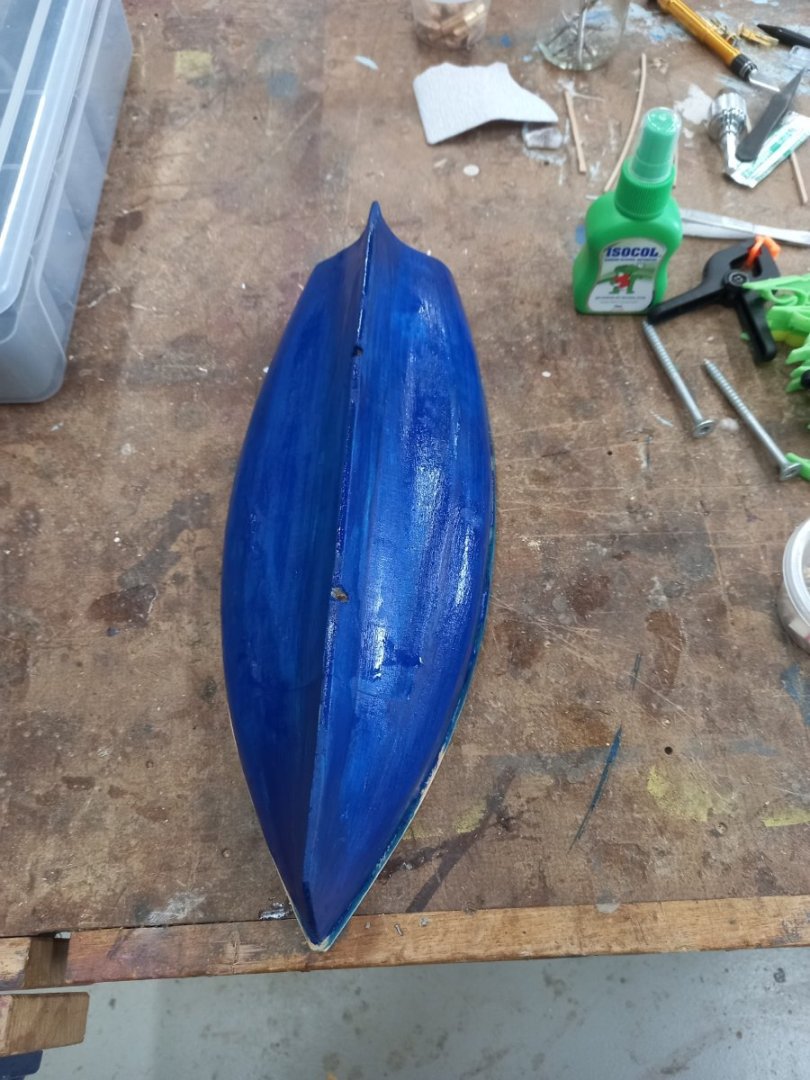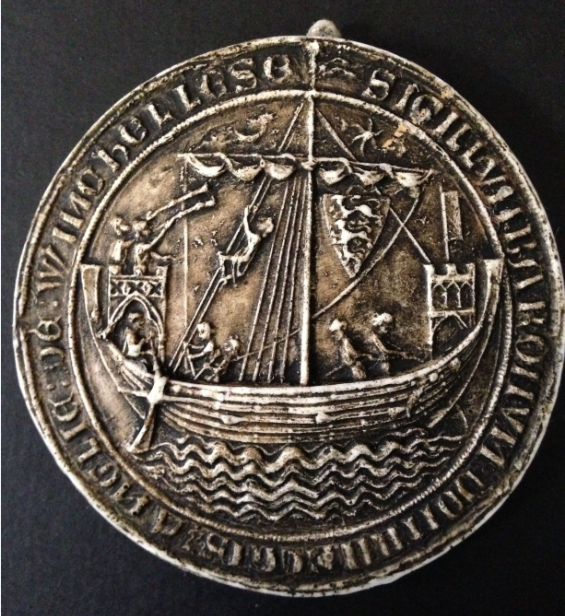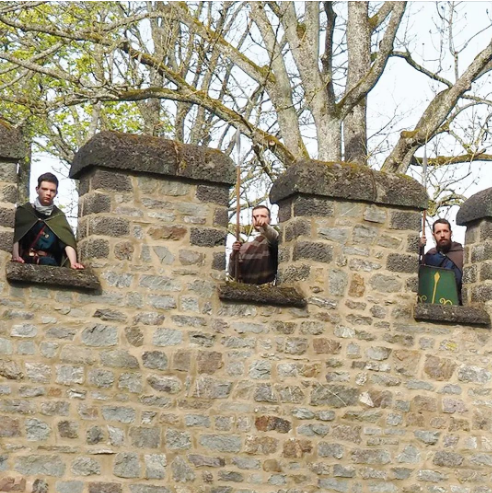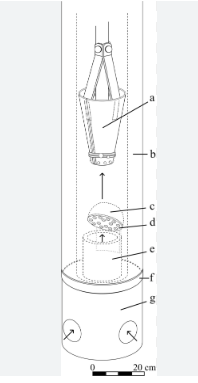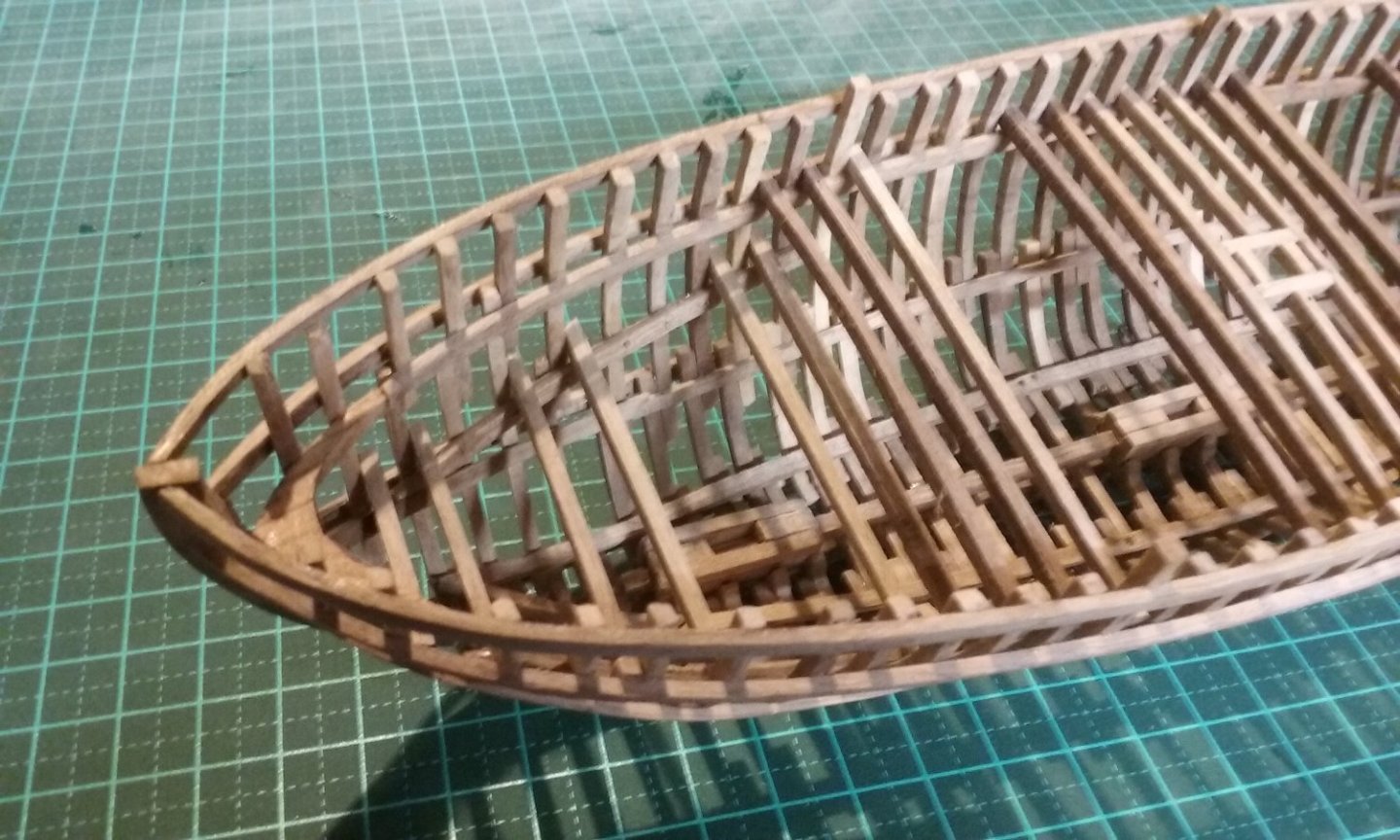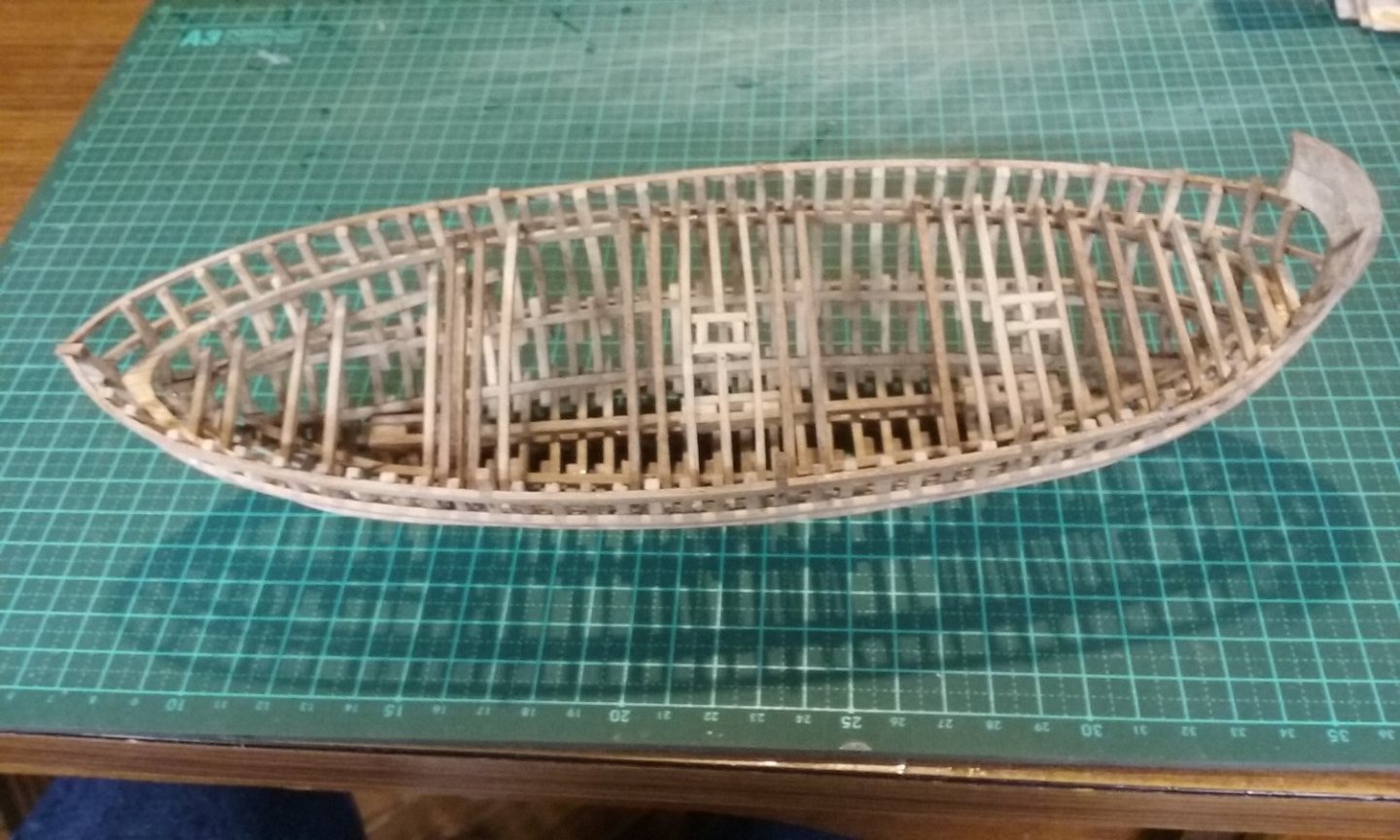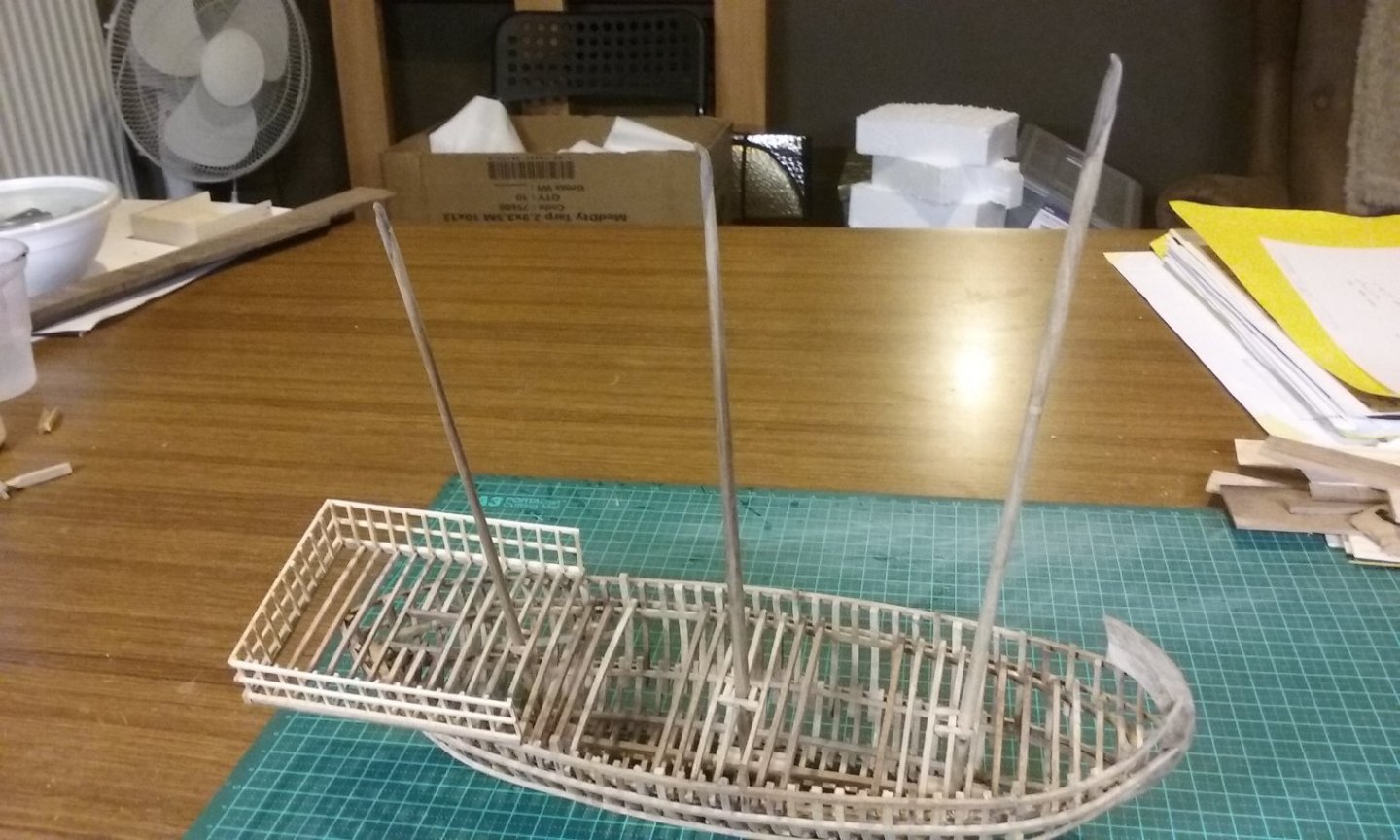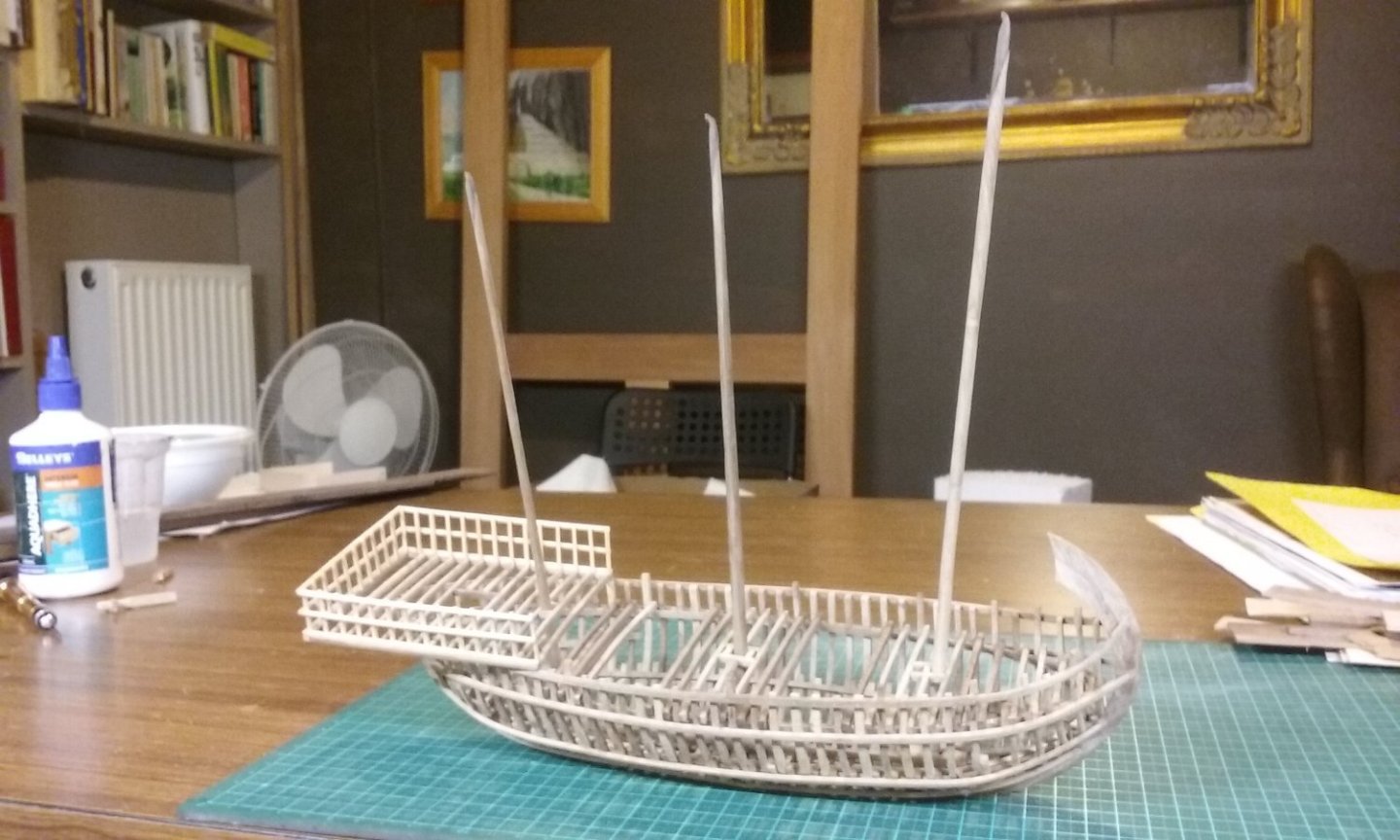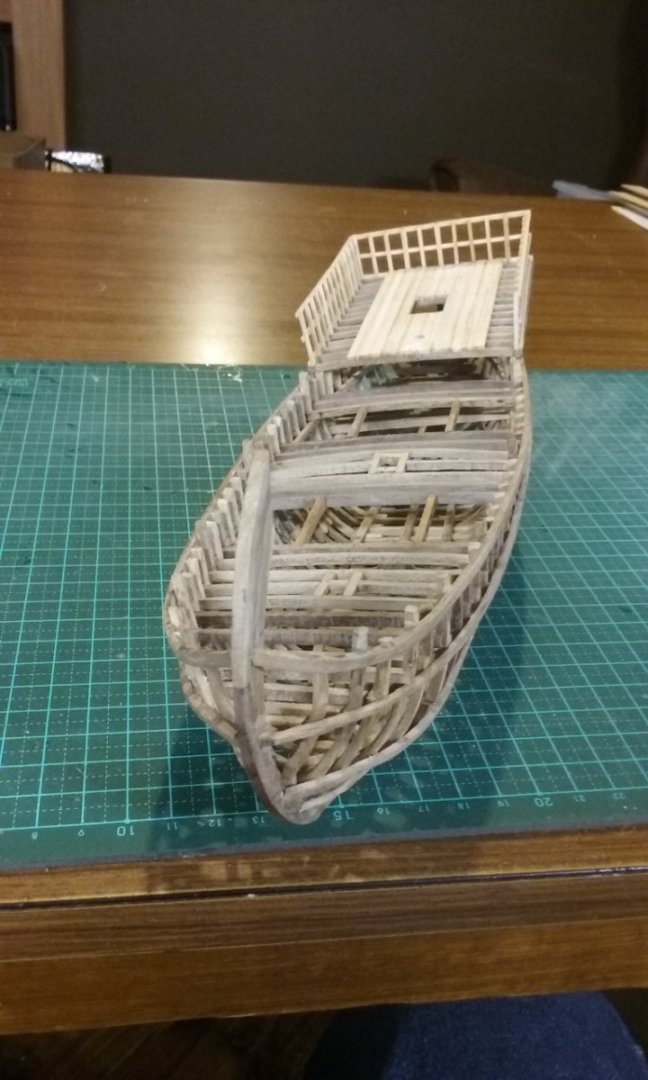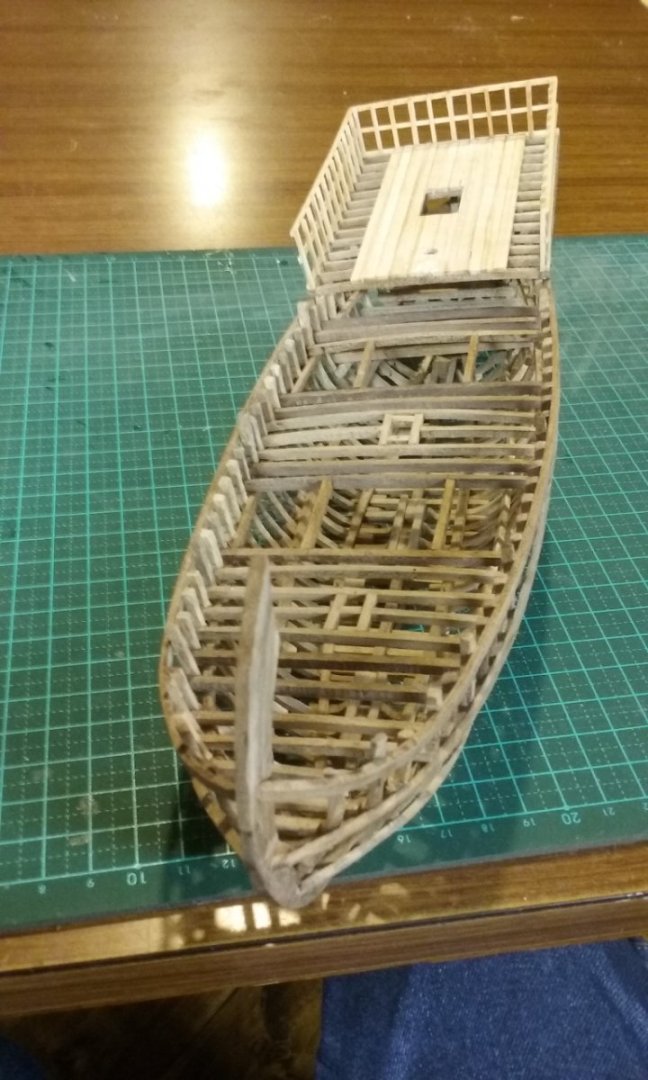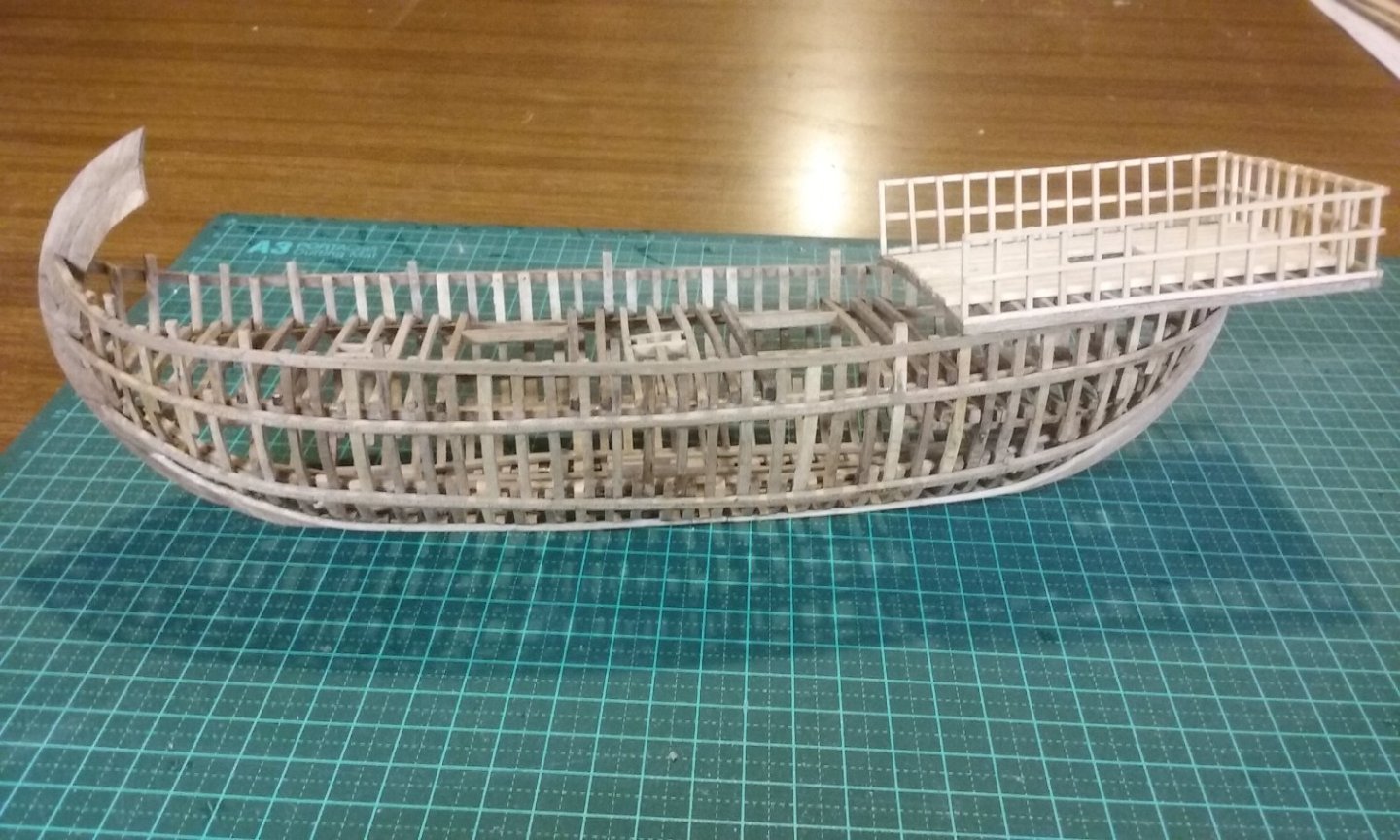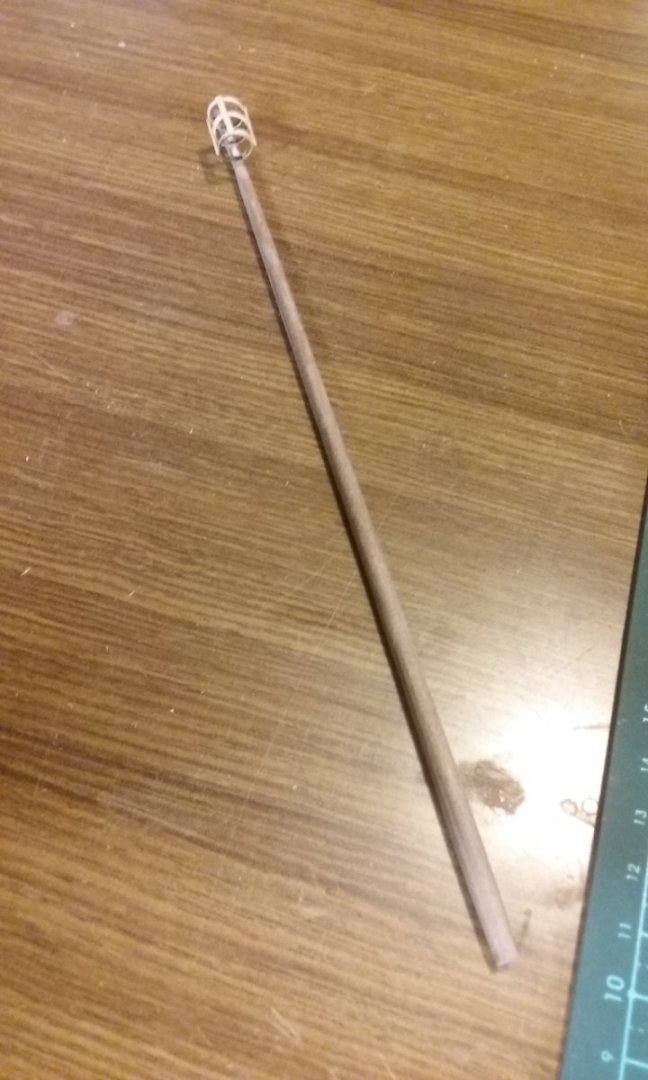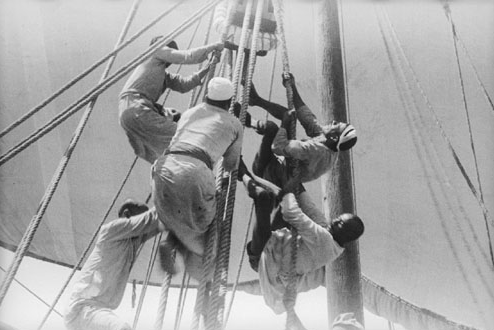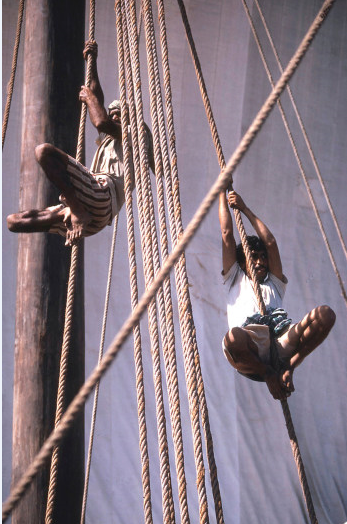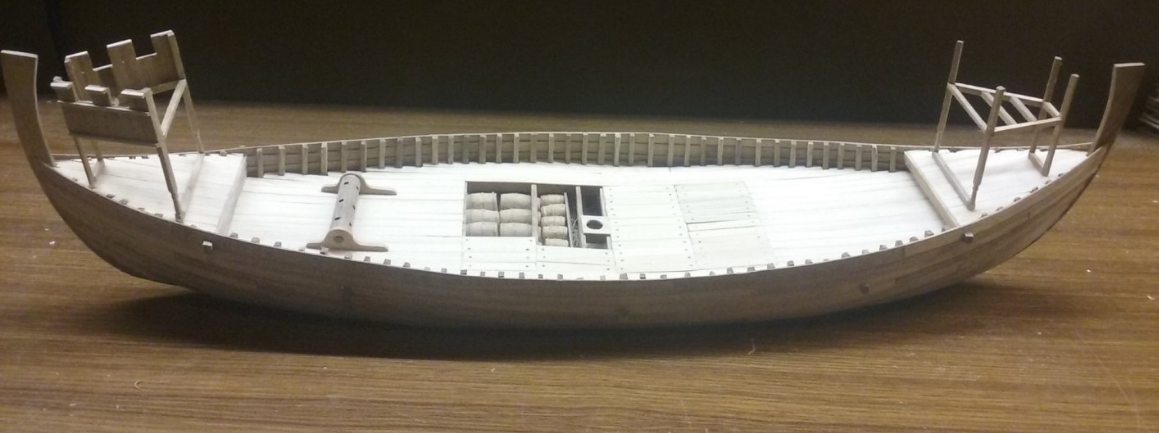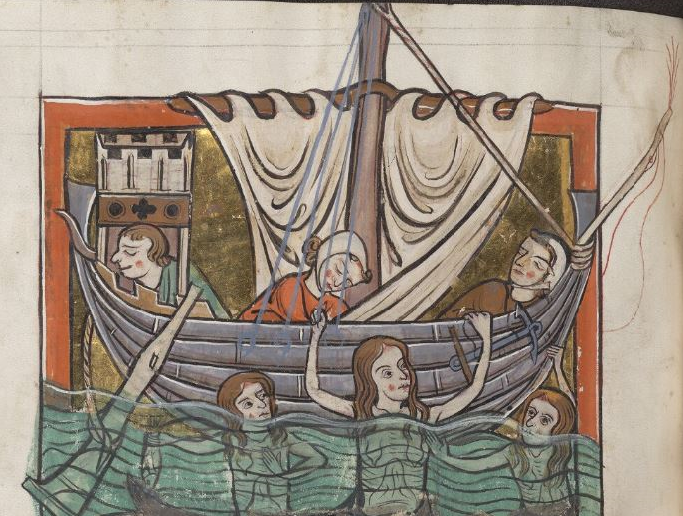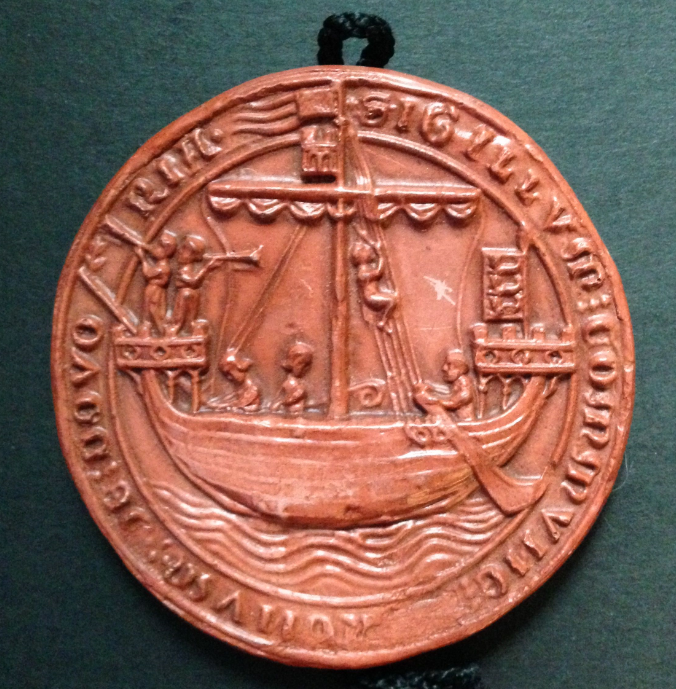-
Posts
7,987 -
Joined
-
Last visited
Content Type
Profiles
Forums
Gallery
Events
Everything posted by Louie da fly
-
Some more painting - that's pretty much complete now. The main problem I have is that in the Men's shed there's usually a thin layer of fine sawdust on everything, and though this doesn't really affect the painting, it does mean I have to be careful not to transfer the stuff from the benchtop or my fingers etc to the dry paintwork - especially the lovely royal blue - almost impossible to get it off if I do. But she's looking very pretty. I chose blue and white as it's such a popular colour among boat owners (who presumably don't care that it makes them invisible against the sea to search and rescue people if there's an emergency). From now on, the main jobs will be making fixtures and fittings - pintles and gudgeons, blocks etc and putting them in place so I can assemble the model into its final form. I've cut out the sails, but I'll have to do some extra work there - not totally happy with how they turned out. Steven
-
No, I work on the ship most days - but the Men's shed is full other days of the week, so Monday and Friday are the only times I get to use the wonderful boys' toys (machine tools) they have there. And I'm leaving the couta boat there to work on when I'm in the mood or between working on the San Marco ship. (Or other things - I replaced the broken plastic handle of my handsaw with a beautiful new hardwood one I'd made from scratch a couple of weeks ago, and there are still the model railway buildings on the back burner.) Steven
-
Thank you, Mark. I agree; they are lovely boats. We go down to Geelong every now and then (a mere hour's drive) and as we go past the bay we often see couta boats moored there. It always lifts my heart to see them - they are so beautiful, and a relic of a past, more elegant era. At the moment I don't think I need any more information, but thanks for the offer. It was never intended to be a 100% accurate model, more just something simple that could be made easily to raise funds for the Men's shed. Turned out not to be that simple. I'm putting the majority of my efforts at the moment into the San Marco mediaeval ship, but a couple of days ago I did some painting on the couta boat - white on the "upper deck". Unfortunately I didn't take any photos of the latest configuration, but here she is with the blue on the lower hull (the holes are for the stand). That was a couple of weeks ago. I'll have to add more photos as I get them, but I only go to the Men's shed Mondays and Fridays. Steven
-
I'm pretty sure other builders of this particular model have encountered the same issue. You're doing a very nice job on this build. It occurs to me that the real ship would probably have had the carvings painted (perhaps in bright colours which highlighted the different gripping beasts) in contrast with the rest of the ship. It was a royal vessel, after all. Yellow and red ochre were available, and a sort bluish grey from wood ash, as well as a black from lamp black. It might have been really colourful. The shields of the Gokstad ship were painted - every second one was black and the alternating ones were yellow. Steven
- 75 replies
-
- Oseberg
- Billing Boats
-
(and 1 more)
Tagged with:
-
I'd say it depends - some of these ships were owned by very wealthy people, and others represented the Cinque Ports, tasked with the defense of the realm (and the prestige of their home port). Look at the ornateness of royal ships in the 17th and 18th centuries. So I think the general run of the mill nefs weren't all that ornate, but some would have been. Regarding the battlements, just make sure you check the heights against the scale - how tall is a normal person in relation to the walls? If they only come up to his knees, they're not going to be much use in protecting him. If he can't see over them, not much use either. Unfortunately, at this time artists didn't show people to scale against the ships they were in. The more important you were, the bigger you were shown. Even the Winchelsea seal shows them too big, though a lot closer to reality than some of the others. Steven
-
Above it - as far as I've seen the castles were open underneath. In fact quite a few of the contemporary portrayals (though not all, by any means) show the helmsman working underneath the aftercastle. Though the supports for the castles were sometimes quite decorative, most were very simple - just uprights -and I don't see there's any need to get complicated with them (unless of course you want to). Steven
-
That's a nice bit of work, mate. Keep it up. I'm looking forward t seeing what you do with the sides of the castles. Yes, come to The Dark Side - you know you want to . . . . Steven
-
After the previous posts I can't believe nobody picked up on this and started making puns about yokes, jokes, yolks etc. (BTW, great work, mate!) Steven
- 290 replies
-
- Quinquereme
- Finished
-
(and 1 more)
Tagged with:
-
Thanks, Jason. We love it here. Beautiful historic city with wonderful buildings dating back to the gold rush. I'm trying to think where that quarry might have been. I can't bring it to mind, but I'm sure there must be quite a few quarries scattered around the place - and it could be at some distance from Ballarat itself, I suppose. MSM are till going strong according to their website, and yes, they're based in the Melbourne suburb of Montrose https://miniaturesteammodels.com/ Steven
- 75 replies
-
- Oseberg
- Billing Boats
-
(and 1 more)
Tagged with:
-
Coming along nicely. Good to see you coming over to the Dark Side (scratch building) if only a little so far. Pumps go all the way back to Roman Times (they even had chain pumps, but they seem to have been lost in Western Europe at least, judging by a comment from a western commentator about them in (I think) the 15th century.) There's evidence suggesting there was a chain pump on the 11th century Serce Limani wreck, lost off the southern coast of modern Turkey, which was then part of the Byzantine Empire, but it's a bit equivocal. However, based on that I put chain pumps on my dromon. There are papers on all this. I can send a couple to you if you're interested. Steven
-
There's a bilge pump found on the Newport ship (2nd half 15th century) - see https://www.newportship.org/archaeology-conservation/artifacts And it works like this:
-
Yes, I found quite a number of them on-line, but I never knew the source. Thanks for enlightening me - and yes, they have often proved very useful. That's fascinating. I never knew about this, and it's really amazing how old proven technology sometimes re-surfaces in the strangest connections. Thanks for letting me know. And now for an update on progress. I think I mentioned that I'd planned to make a cabin below the aftercastle, for the captain/owners. First I needed to install clamps to support the ends of the cabin's deck beams. It was fairly complicated trying to get the curve and orientation just right, but I think I succeeded pretty well. Here's the stern with the aftercastle removed, and some of the deck beams in place. And an overall view from above. Finished all the masts and dry fitted them. The mast steps and mast partners line up quite well, with a little wriggle room to get the masts exactly vertical when looking from the bow/stern. They are all somewhat raked - the foremast (which is in fact the MAIN mast) has quite a pronounced rake forward, the other two slightly back. Lining up the mast partners in the two decks (aftercastle and cabin) to achieve this is an ongoing project, but I think it's going to be ok. Note that they all now have their calcets in place. I tried to get a good contrast in colour between mast and calcet, but I may have to do a bit more to emphasise it. And planking on the aftercastle deck. You can see the hole for the mizzen and the opening for the stairs down to the cabin. And on the main deck the mast partners and the beams that form the sides of the two hatches, waiting for more deck beams either side of them, to complete the deck structure. I'm planning to have a wall at the forward end of the cabin, with a door leading into the hold via a ladder, so the captain and owners can access the cargo without having to go up a ladder to the poop, down another to the main deck and down a third to get into the hold. I expect I'll have doors to close off the hatches and the companion, as in Woodrat's Venetian round ship. Here's the first "crowsnest" attached to the mizzen mast just below the calcet. It doesn't have a floor yet; I'm still working out how to keep the halyards/tyes from fouling this structure - I won't have a definite answer until I install the knights on the deck and run the halyards/tyes to them. Steven
- 508 replies
-
All good questions, but this is what is shown on these seals, not just the Winchelsea one but others as well. And regarding climbing the rigging, there's this (Crewmen on 20th century dhows) Woodrat made one from a bit of creeper out of his garden, in his "Elusive hulc" build. See post #125 at but you've come up with a good workable alternative. Nice paintwork, by the way. The first Atlantic ship, as the nef is part of the Atlantic tradition. There are Mediterranean ships shown with castles at each end on the leaning tower of Pisa (probably from the late 12th century) and in the Annals of Genoa (last decade of the 12th), but these are lateeners, not part of the nef tradition in my view. In fact, for the Med we can go right back to about the 10th century, when dromons are described as having central wooden castles (xylokastra), or even earlier, to Roman times, when warships had a central castle. Looking forward to seeing how you solve this one. I was aware of the standing-space problem on my own nef. Though I had a hole for the ladder in each of the castles, I put it at the extreme inboard edge. Nonetheless it had a crossbeam at the outer edge of the opening that you'd have to duck your head to avoid (this was for structural strength). I'm not sure they existed at this time. I've seen one on the Bremen cog, but that's dated 1380 or so, but windlasses are a pretty definite thing. Coming along nicely. I look forward to the next instalment. Steven
-
Basically the equivalent vessels - at least in the Atlantic - were nefs but without castles, at least as far as the pictorial evidence shows. As I mentioned above, the first I've seen with castles were c. 1225, and they only had a single castle, at the stern. Steven
-
OK, taking on board (sorry!) the constraints imposed by the plastic model, that it's impossible to achieve all the changes that may be desirable for historical accuracy etc, plus the public the model is intended for (i.e. people who don't know - and probably wouldn't care - about the things that distinguish a nef from a longship with castles added), I think it's just a matter of seeing what's possible - to get as close as you can to what you have in mind - and don't sweat the small stuff (even, though it pains me to say it, to the point of leaving the mast step as it is). Steven PS: You might consider changing the date a bit - the earliest date I can find for a nef with castles is 1225 (though the seal of Dunwich is dated at circa 1200, that circa covers a lot of ground).
-
Perhaps make a new deck out of wooden planks? If you widen the ship and lift the deck as I mentioned, the existing plastic deck will possibly be too narrow anyway. (just part of my evil plot to steer you to the Dark Side of working in timber). To me as well, but it's a matter of aesthetics and personal choice. Can I recommend against that? I've seen pics of models with triangular castles, but the pictorial evidence suggests they were rectangular, or at the most trapezoids tapered towards the ends, as the castles weren't big and heavy enough to warrant tapering to a point at this time, as they were later with carracks (even the early carracks had rectangular or polygonal forecastles). Regarding supporting the castle against the sternpost, I can't see that there would be anything wrong with that. There was probably a period of transition between free-standing and integral castles when that was tried out. Took me a while to get the reference - of course, it has St Mark's body on board. But I'd call it a reliquary, not a hearse. No, this is c. 1150; cogs hadn't yet been developed in the Atlantic and certainly hadn't made their way to the Mediterranean. They seem to have come into use in the 14th century - at the very earliest maybe the end of the 13th century. My ship is a nave, or perhaps a nave (ro)tonda, a round ship; so-called to distinguish them from long thin galea sottile (galley). I'm afraid they're oarports. Nefs don't seem to have had them at all, so I suppose you'll have to close them up - perhaps car-bog would do the trick. Hmm, not sure I agree with this. Not as strong, for a start - as the vertical force (weight of the castle) acts on a non-vertical column it would tend to make the column "overturn" (pivot around the lower support). And this would be exacerbated by the motion of the ship in the waves loosening the connection. As I see it, these supports were vertical and somewhat inboard - the deck beams would be amply strong enough to support the columns, particularly if the structure is stiffened with horizontal beams at deck level as shown below. Steven
-
In a few words, it's swivelled from side to side as you do with a stern rudder. Works just the same as a stern rudder, right down to having a tiller. But Mediterranean ships usually had one on each side, often with a single steersman holding both tillers at once. Side rudders also swivel in the vertical plane, but that's just to get them out of the way (i.e. out of the water) when the ship enters port/is in shallow water etc. Or so you can use just a single one. For more information on the whole side rudder thing, I'd recommend you read The Development of the Rudder A.D. 100-1600: A Technological Tale by Lawrence V. Mott of Texas A&M University. It used to be freely available on-line along with a huge number of other master's theses in the University's website, but when I checked recently it went to a general site that just told you about the University itself. A terrible shame; it was a really good resource. Apparently it's now published as a book which you can buy, or access through inter-library loan. BTW, Mott makes the point that side rudders are actually more efficient in steering a ship (of this size and type, presumably) than a stern rudder, as they're freer of the turbulence caused by the hull. BTW, traditional whaling boats still use a steering oar - they race them here in Victoria, Australia. I've seen them in action. Steven
- 508 replies
-
Yes, frames can be boring sometimes, but once complete they certainly add to the verisimilitude of the model. Coming along nicely. Steven
- 134 replies
-
- sea of galilee boat
- SE Miller
-
(and 1 more)
Tagged with:
-
You're doing a good job of this. I've seen others that had quite a bit of difficulty, particularly with the upper planking, but you seem to have taken it in your stride. Nice clean work, too. Steven
- 75 replies
-
- Oseberg
- Billing Boats
-
(and 1 more)
Tagged with:
-
Ok, I like the idea. I would incline toward a nef - if only because they appear so rarely in modelling. (Oh, and I might have a personal interest, I suppose). A couple of points. First the name. If it's a nef, I wouldn't call it Beowulf. Though written down (probably) in the 11th century and in a Christian mileu (references in the text comparing Grendel to Cain, for example), the story describes event from many centuries earlier, which is probably when it was first composed, but equally probably not written down until the 11th century. Having said that, you're at liberty to call it anything you want - it's your model. But as nefs are a phenomenon of the late-13th and early/mid-14th centuries, I'd be thinking of a name more appropriate to the period. Easy to say, not so easy to do. At the moment I can't think of any known ships' names from this period, but later ones seem to have been either religious or royal - Holigost, Grace Dieu (both early 15th century), Great Michael, Mary Rose, Peter Pomegranate (after the coat of arms of Catherine of Aragon - mid-16th) for example. If I think of any more appropriate to the time I'll chime in again. The ship which sank and drowned King Henry I's only son in 1120 (leading to a civil war over the succession) was known as the White Ship, but I believe that was a description, not its name. Then there was William the Conqueror's ship Mora, but that's back in the 11th century, and the names of Viking ships such as Ormen Lange (Long serpent) are earlier still. Oh, just found the names of two English ships captured by the french in 1338, in raids that culminated in the battle of Sluys, 1340 - towards the very end of the nef's period, when cogs were taking over - the Christopher and the Cog Edward - as you can see, one Biblical and the other royal. Secondly there are two kinds of vessels that get categorised as nefs - the earlier ones with free-standing castles and the later ones where the castle is somewhat incorporated into the hull. Choose whichever one you like more. In the first type take note of the shape of the stem and sternposts. They are VERY characteristic of nefs and of no other ship. There are more examples in my build log. See also https://www.pinterest.com.au/lowe1847/mediaeval-nefs/ And also note that many of the earlier type have only a single castle - always at the stern. Regarding the hull shape, as it's a plastic model there's nothing you can do to change it, so just go with what you've got. But I believe you could alter the stem and stern somewhat to be closer to a nef. To make it resemble a cargo ship more closely you might think of building up the sides somewhat, and raise the deck to allow more cargo storage. And I'd get rid of the (admittedly beautiful) mast step - whatever shape it was by the late 13th century (and we're talking maybe 300 years of evolution) it's more likely to have been hidden below decks. I suppose that's all for now, off the top of my head. If I think of anything else I'll let you know. Have fun with it. Steven
-
Yes, happy to help. I take it you haven't started a build log yet. Steven
- 508 replies
-
Thanks, mate. A lot of work and very fiddly, but worth it. Now, back to your regularly scheduled program. Steven
About us
Modelshipworld - Advancing Ship Modeling through Research
SSL Secured
Your security is important for us so this Website is SSL-Secured
NRG Mailing Address
Nautical Research Guild
237 South Lincoln Street
Westmont IL, 60559-1917
Model Ship World ® and the MSW logo are Registered Trademarks, and belong to the Nautical Research Guild (United States Patent and Trademark Office: No. 6,929,264 & No. 6,929,274, registered Dec. 20, 2022)
Helpful Links
About the NRG
If you enjoy building ship models that are historically accurate as well as beautiful, then The Nautical Research Guild (NRG) is just right for you.
The Guild is a non-profit educational organization whose mission is to “Advance Ship Modeling Through Research”. We provide support to our members in their efforts to raise the quality of their model ships.
The Nautical Research Guild has published our world-renowned quarterly magazine, The Nautical Research Journal, since 1955. The pages of the Journal are full of articles by accomplished ship modelers who show you how they create those exquisite details on their models, and by maritime historians who show you the correct details to build. The Journal is available in both print and digital editions. Go to the NRG web site (www.thenrg.org) to download a complimentary digital copy of the Journal. The NRG also publishes plan sets, books and compilations of back issues of the Journal and the former Ships in Scale and Model Ship Builder magazines.



